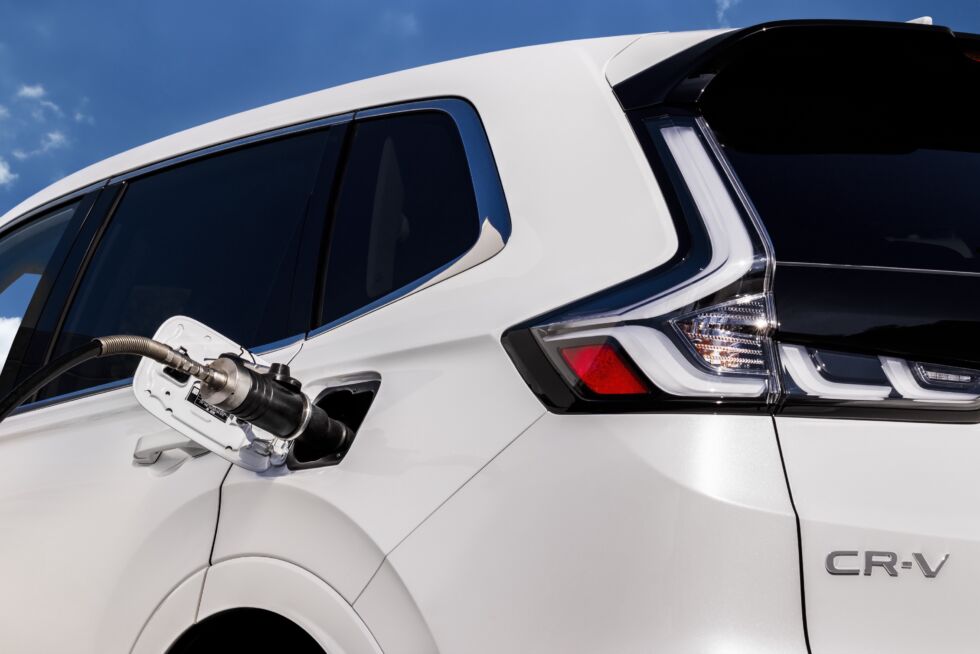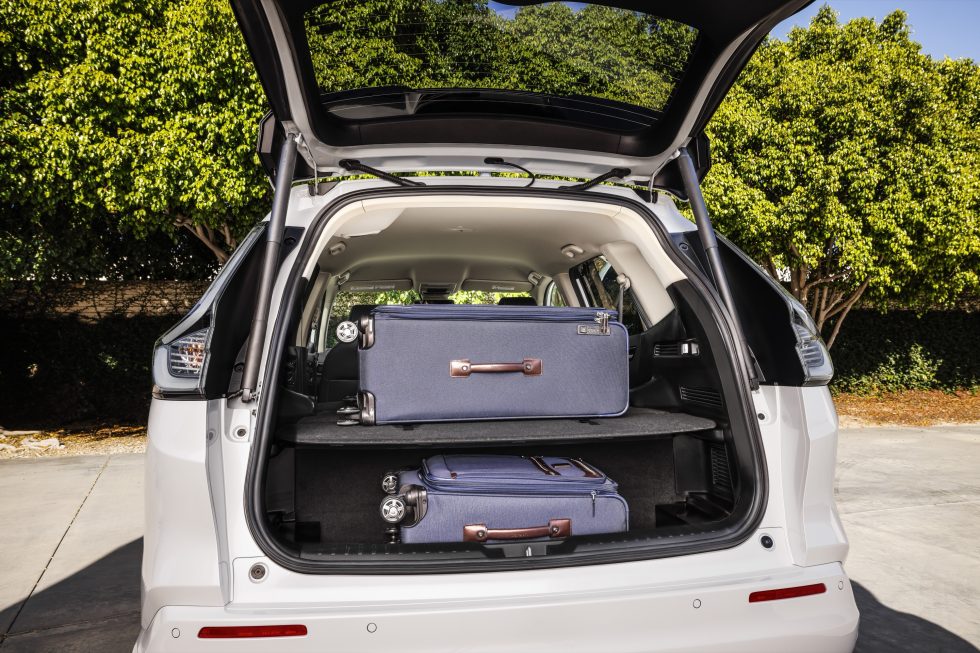
Honda
Hydrogen as a fuel source for light passenger vehicles is a tough sell in the US. It has a woefully underdeveloped refueling infrastructure in the US, being almost nonexistent outside of California, and even there, retail hydrogen stations are closing down. And hydrogen prices fluctuate like crazy, with recent costs hitting $33 per kilogram, when you can even get it. In short, it seems like a weird time for a company to introduce a new hydrogen fuel cell vehicle, but that’s just what Honda is doing with its awkwardly named CR-V e:FCEV.
The fuel cell CR-V is unique in a few ways that make it interesting, the biggest of which is that it’s effectively a plug-in hybrid, only instead of an internal combustion engine being paired with an electric drivetrain, this has a fuel cell powering a 17.7 kWh battery pack and a traction motor that bears more resemblance to one you’d find in an EV than in a traditional PHEV. Cool, right?
The biggest question that we have is simply why?
Honda’s answer is that this is part of a long-term plan to make hydrogen a more relevant fuel, not only for passenger vehicles, but also for heavy-duty vehicles, agriculture, and stationary backup power systems. That’s pretty bold when companies like Shell, formally bullish on hydrogen, have stated that they won’t continue investing in the fuel.

Honda
The FCEV pairs the aforementioned 17.7 kWh battery with a single front-mounted electric motor which is good for 174 hp (130 kW) and 229 lb-ft (140 Nm) of torque. That’s not exactly going to blow anyone’s socks off, especially compared to the standard hybrid model’s 204 hp (152 kW). Part of that battery capacity is used as a buffer for the fuel cell in place of the previous Clarity FCV‘s supercapacitor.
This vehicle introduces a new and more efficient generation of fuel cell for Honda, which it co-developed with General Motors, and according to the EPA, this CR-V will go 270 miles (434 km) on a full tank of hydrogen and a fully charged battery. Honda also claims that the new fuel cell should be twice as durable as the previous version found in the Clarity FCV thanks to the use of new, more corrosion-resistant materials.
Apart from all the concerns about future viability and fuel availability, what is the CR-V e:FCEV like to actually drive? Well, the good news is that it drives like a CR-V (mostly), albeit one with a few quirks.
The first thing that becomes obvious once underway is that the FCEV is heavier than the CR-V Hybrid we get here in the US—a full 500 lbs (227 kg) heavier, according to Honda engineers. That weight isn’t necessarily a bad thing, though. The standard CR-V isn’t exactly known for cornering like a Civic Type-R, so while the FCEV feels slower to react to inputs, it also feels more composed and solid around town.

Honda
That weight also makes its presence known under braking. Even when slowing from around-town speeds, you’re definitely applying more pressure to the pedal than you do with the regular hybrid. Braking performance is helped somewhat by regenerative braking, which is controlled by some very nice metal paddles on the steering wheel. There is no one-pedal driving, and the regen resets itself rather quickly once you set off again, but it’s better than nothing.
Like other CR-Vs, the FCEV features four drive modes that are accessed via a switch on the center console: Sport, Normal, Eco, and Snow. There are also some more modes that are unique to the FCEV that are accessed by an “E” button near the mode switch. These modes allow you to either set off purely in EV mode with the fuel cell disabled, drive in normal mode with the fuel cell on, or access a charge mode that uses the fuel cell to charge the battery.
Like many other Hondas, the CR-V e:FCEV suffers from a lack of sound deadening and insulation, which isn’t that big of a deal when you have that noise competing with an internal combustion drivetrain. In the FCEV, that makes things like road noise seem much more pronounced than it otherwise would. My test drive loop is both short and limited to city streets, but I’d assume the FCEV is a noisy little beast on the freeway.
When it comes to driver assistance technology and infotainment, as well as things like interior layout and finishes, the fuel cell CR-V is essentially just a really nicely equipped production CR-V. You still get things like Honda’s “Honda Sensing” suite of advanced driver assistance features as well as conveniences like Android Auto and Apple CarPlay. There’s also a neat little power-flow animation in the infotainment menu that’s similar to the one you get in a CR-V Hybrid, but it shows a little hydrogen tank instead of the battery.

Honda
Other shortcomings of the FCEV include the previously mentioned cost of hydrogen. The FCEV has a 4.3 kilogram-capacity hydrogen tank. At $33/kg, suddenly you’re paying the equivalent of filling up a full-size Range Rover to go 270 miles. That’s not awesome, but there is a small redeeming factor and that’s the fact that the FCEV can drive on battery power alone if the fuel cell is depleted. It can also drive on a mostly dead battery if there is hydrogen to convert.
The fact is, though, that the CR-V e:FCEV isn’t meant to compete with other electric vehicles or plug-in hybrids, or really even other fuel cell vehicles like Toyota’s Mirai and Hyundai’s Nexo. Like the Clarity and the FCV Clarity before it, this vehicle is essentially a tool being used to gather data. We imagine anyone likely to lease it is already a hydrogen convert and won’t be put off by the day-to-day annoyances a vehicle like this can bring.
Honda plans to build around 300 FCEVs per year, and since they’re being offered exclusively as leases and exclusively in California (at least in the US), this isn’t a volume vehicle by any stretch. As in the past with its other fuel cell vehicles, Honda will take the vehicles back once their leases are up and pull them apart to see what’s worn, and how, to better understand how these vehicles are used. This data may, in turn, be used to create a more mass-market-oriented vehicle later down the line.
At the beginning of this whole endeavor, I asked why Honda is bothering with the CR-V e:FCEV and with hydrogen in general. Honda’s staff will give impassioned speeches about how Soichiro Honda encouraged his employees to “Dream,” but I think the real answer is more cynical than that. Honda is late to the BEV game. Its in-house efforts like the Honda E have been almost violently adorable and even desirable, but technologically lacking compared to the competition.

Honda
The partnership between Honda and GM that has resulted in the Prologue and Acura ZDX isn’t likely to propel the brand to the forefront of even Japanese EV manufacturing, especially considering all the difficulties GM has had with the Ultium tech. The fuel cell drive is something that the company is comfortable doing, which allows it to look very forward-thinking and bold while continuing to sell, admittedly, excellent and quite efficient hybrid and pure internal combustion vehicles.
So, the CR-V is flawed but fine and doesn’t really make a case for itself because, well, it doesn’t have to.





















+ There are no comments
Add yours